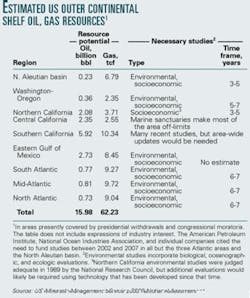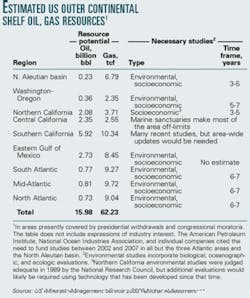The US Minerals Management Service will begin a 21/2-year process developing the next Outer Continental Shelf 5-year plan when it requests comments and nominations this month. The plan for 2007-12 will exclude all but the central and western Gulf of Mexico because the other areas remain under presidential withdrawal or congressional moratoriums.
But an official of the US Department of the Interior urged members of MMS's OCS Policy Committee to consider whether future evaluation and development of the excluded areas' oil and gas resources could be in the national interest.
Nigerian export turmoil contributed to the recent jump in oil prices past $50/bbl along with Gulf of Mexico production losses in the wake of Hurricane Ivan, MMS Leasing Division Chief Renée Orr said. US reliance on imported oil has passed 60%, with much of it coming from politically unstable regions, and the country's LNG imports are poised for steady growth, she told the committee.
As US oil and gas consumption grows, it competes with increasing demand in India, China, and other developing nations, Orr continued.
"We have to assess how these imports affect our national security," she said.
There also have been many technological, economic, and security changes since the presidential withdrawals and congressional moratoriums were put in place. Studies would be needed to determine the economic and environmental impacts of additional oil and gas activity on the OCS.
"What is the information we need to address questions that may be asked? It's part of our responsibility in developing a leasing program to consider all these factors," Orr maintained.
Political challenge
Committee members, including representatives of state and local governments, other federal departments, an environmental organization, and oil and gas industry segments, acknowledged that there would be a major political challenge to any effort to even evaluate, let alone explore and produce, oil and gas from more of the OCS.
Several members also took note of estimates from MMS's 2000 National Assessment that Orr presented of nearly 16 billion bbl of oil and more than 62.23 tcf of gas potentially in the OCS outside the central and western gulf (see table). The agency conducts the assessment every 5 years and will release updated figures in 2005. "This country has resources," MMS Director Johnnie Burton said. "The question is whether the administration and Congress want to change the situation. We don't know. But we intend to start with the administration."
Congressional OCS moratoriums that began with 736,000 acres off California in the early 1980s reached 84 million acres by 1990. That year, then-President George H.W. Bush excluded Northern and Central California, Southern California (except for 87 tracts), Washington, Oregon, Southwest Florida, and the North Atlantic Sale 96 planning area from lease sales until 2000. Congress also amended the Oil Pollution Act of 1990 to prohibit leasing and drilling on existing leases off Northern Carolina.
Bush withdrew the 87 Southern California tracts he exempted 2 years earlier in 1992, and his successor, Bill Clinton, extended the presidential withdrawal to all areas under congressional moratoriums through 2012. The withdrawals and moratoriums do not prevent MMS from performing environmental studies of the closed-off areas. Annual budgets have made the agency concentrate such efforts in OCS regions that are available for leasing, however.
"Although we are not prohibited from going into the moratoria areas, our budget is based on areas we manage," said Burton. "I believe there was an attempt in the last Congress to authorize money for such studies, but it didn't pass."
Industry representatives on the committee echoed Orr's observation that offshore production technology has improved significantly since the moratoriums and withdrawals took place.
"I wonder how realistic the resource estimates are in light of the technology advances," said Galen L. Cobb, vice-president of industry services at Halliburton Energy Services in Houston.
Techniques for evaluating environmental, social, and economic impacts of increased oil and gas activity along the OCS also have improved, which probably would make new studies necessary, committee members from state and local governments pointed out.
Improvements are needed in environmental impact assessments, processing damage claims, compensation and the leasing process overall, said George H. Ahmaogak Sr., mayor of Alaska's North Slope Borough.
G. Ramachandran, a council member from Louisiana's St. Charles Parish, added, "Local input in decision-making seems to be lacking."
Other committee members said that outside research could provide starting points. "The scientific community has weighed in on possible broad-based impacts," said Deerin Babb-Brott from the Massachusetts Coastal Zone Management Office in Boston.
New studies
Deborah Tucker, from Florida's Department of Environmental Protection in Tallahassee, suggested that the National Research Council and similar organizations might be approached to help determine new studies that would be needed and their scope. So could coastal states. "A few years ago, they presented their own projections of energy demand and their plans for meeting them," said Sandra M. Fury, senior regulatory and advocacy advisor in ChevronTexaco Corp.'s North America upstream Gulf of Mexico business unit.
MMS officials also noted that other decisions made since the regions were put off-limits could preclude possible future evaluation and development, notably the establishment of the Monterey Bay and several other marine sanctuaries along the Central California coast.
It is also uncertain the extent to which improved technology would increase industry interest in areas previously considered uneconomic. Committee members and MMS officials pointed out that technology developed as the industry has moved deeper into the Gulf of Mexico could make production more efficient and less intrusive.
"Production in the gulf is increasing, but overall US production is declining," said James E. Carlton III, land manager at ConocoPhillips in Houston. "The MMS can provide incentives, but eventually it will encounter a wall. That inevitably brings us back to the access issue."


